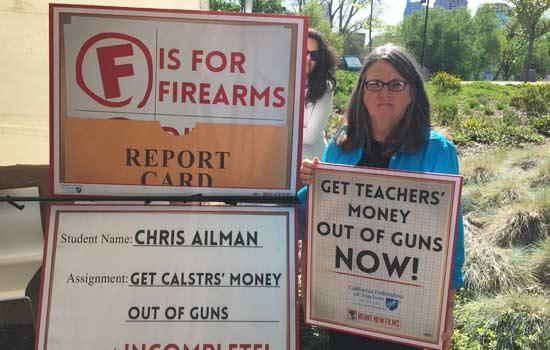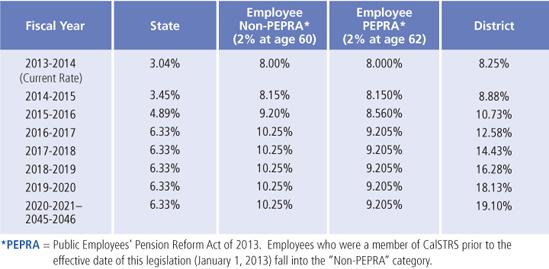CFT to sponsor essential legislation for 2023-2024 legislative session
Legislative Update
INTRODUCTION
With the 2023-2024 California Legislative Session beginning, the CFT will be engaging in a new environment at the state Capitol. With several education champions reaching their term limits, and a large sector of the legislative staff turning over, the Legislative Department will be focusing on building new relationships with newly-elected legislators and their staff.
How CalSTRS and CalPERS pensions are protected from inflation
Governor signs CFT-sponsored legislation to provide earliest CalSTRS retirees another supplemental check
Both CalSTRS and CalPERS have mechanisms in place to guard a retiree’s defined benefit pension against eroding purchasing power. The first is a cost-of-living adjustment, or COLA, and the second is a “floor” below which the buying power of a pension cannot fall. Now thanks to a CFT-sponsored bill recently signed by Governor Newsom, CalSTRS retirees from earlier decades will see additional relief.
Governor signs six CFT bills, plus budget trailer bills with union priorities
Legislative Update
Governor Newsom signed six union bills at the end of September that the CFT successfully lobbied in both houses of the Legislature. The CFT had sponsored or co-sponsored 16 legislative bills alongside several budget proposals in the last year of the 2020-22 legislative session. A majority of these priorities made it to the governor’s desk or were included in the state budget, with only one bill being vetoed by the governor.
Governor provides flexibility to hire retired teachers, staff during pandemic
Allows retirees to return to work within 180 days of retirement
On August 16, 2021, Governor Newsom issued Executive Order N-12-21 to provide additional flexibility to hire retired K-12 teachers, community college faculty, and classified staff during the COVID-19 State of Emergency.
CFT members call on CalSTRS to pressure companies to stop profiting off family separations at the border
Several CFT leaders and members testified today at the CalSTRS Investment Committee meeting in West Sacramento, urging the second largest pension fund in the country to pressure companies that they invest in to stop profiting off family separations at the border.
CalSTRS pensions analyzed in light of GOP attacks
Teachers do much better with defined benefit plans than 401(k)s
Most public school teachers working today count on traditional pensions — which guarantee a monthly income based on age, salary and years of service — as their main source of financial security in retirement.
Pension battles shift from ballots to courts
Tracking the latest strategies that attack public employee pensions
For years, people have been trying to attack pensions with ballot propositions, said Doug Orr, an economics professor at City College of San Francisco and the chair of the of the CFT Retirement Policy Committee. Those propositions always go down in defeat, Orr said, and now those attacks on pensions are coming to the courts.
CFT urges CalSTRS to divest from gun manufacturers now
New documentary film Gun-Free Retirement features CFT members
In April 2013, a few months after the shootings at Sandy Hook Elementary School in Connecticut that killed 20 children and six adult staff members, the board of California State Teachers’ Retirement System voted to divest from firms making weapons that are illegal to own in California. More than two years later, that hasn’t happened, and Joshua Pechthalt, president of the CFT, wants to make sure it does. Soon.
Freeway Flyers: Local action & quick news
Santa Maria part-timers negotiate numerous improvements
Part-time instructors at Allan Hancock College negotiated an 8 percent pay increase over the next two years starting this spring when all part-time academic employees received a 4 percent salary increase. They will get a 2 percent raise this fall and another in fall 2016. In a tremendous boost, service faculty (counselors, librarians, and nurses) received an additional 20 percent pay increase.
CFT pushes CalSTRS to divest from gun manufacturing
UPDATE! On June 5, 2015, CalSTRS cashed out of its investment in gun manufacturer Remington Firearms, part of the Cerberus Capital Management portfolio. We thank CalSTRS for listening to CFT. Read story in the Sacramento Bee.
- State Treasurer John Chiang weighed in, supporting the action to divest, in a letter to CalSTRS.
- Read more
- VIDEO: Gun Free Retirement: How teachers are funding gun companies against their will
- IN THE NEWS: “CalSTRS wont rush to sell firearms investment,” Sacramento Bee
- IN THE NEWS: “California teachers demand a gun-free retirement,” KCRA
CalSTRS offers more assistance with service credit reporting
By Sharon Hendricks, Los Angeles College Faculty Guild and CalSTRS Board Member
To help part-time faculty understand how districts report service credit and to ensure they receive all service credit they have earned throughout their teaching careers when they retire, CalSTRS has opened new centers in Irvine, Glendale, and Santa Clara, staffed by benefits counselors trained to navigate part-time-faculty issues.
Legislature passes significant changes in CalSTRS contributions
In June 2014, the California Legislature made significant changes in contributions to the California State Teachers Retirement System. The CFT formed a task force to study the issue of the system’s “unfunded liability” and to submit the union’s recommendations to the governor and the Legislature. Learn about the changes passed by the Legislature and the union’s positions below.
CalSTRS Board Member: Perspective on the shortfall
CalSTRS reports that its unfunded liability grows by $22 million every day that nothing is done. While most California public pension funds can raise annual employer rates when they need more money, CalSTRS requires legislation to raise rates.
CFT advisory committee analyzing impact of CalSTRS funding gap
The Legislature has begun public hearings to address a $71 billion funding gap in the pension system for K-14 teachers. Without an increase in contributions, CalSTRS predicts its assets will be depleted in about 30 years.
Don’t sign! State initiative attacks public employee pensions
San Jose Mayor Chuck Reed is mounting a major attack on educators’ pensions. He has filed a voter initiative with the Secretary of State and may start collecting signatures in early 2014 to qualify it for the November ballot.
CFT wins improved CalSTRS service credit reporting
New law takes effect July 1
In a victory for part-time community college faculty enrolled in the CalSTRS retirement program, Gov. Brown signed into law CFT-sponsored SB 114 to correct the misreporting of retirement service credit.
Governor Brown signs bill to improve reporting for adjuncts
The governor signed CFT-sponsored SB 114. Authored by Sen. Leland Yee (D-San Francisco), this bill helps correct misreporting of part-time faculty work to ensure the right amount of retirement service credit.
New employees to face reduced retirement benefits
Workers not yet hired will take biggest hit under law passed by legislators with no input from public employee unions
A new law passed in the final hours of the legislative session makes sweeping changes to public employee pensions that impose most of the changes on workers not yet hired, creating a two-tier system in the workplace where two groups of workers doing the same work receive different retirement benefits.
CFT bills limit overload, correct service credit reporting, and require rehire rights
In 2012, CFT sponsored three bills that aim to improve the working conditions for part-timer faculty. What are the bills and how can they help you in the workplace? Find out in the recap below.
Pajaro Valley community succeeds in banning carcinogenic methyl iodide
Teachers at Ohlone Elementary School were greatly relieved when Arysta LifeScience, a Japanese chemical company, announced on March 20 that it would no longer sell methyl iodide in the United States for use as a pesticide.







